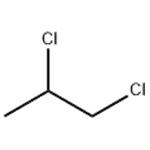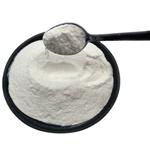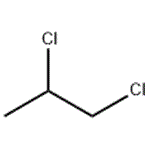- 1,2-Dichloropropane
-

- $100.00 / 1KG
-
2023-12-26
- CAS:78-87-5
- Min. Order: 1KG
- Purity: 99%
- Supply Ability: g-kg-tons, free sample is available
- 1,2-Dichloropropane
-

- $10.00/ kg
-
2023-08-04
- CAS:78-87-5
- Min. Order: 1kg
- Purity: 99%
- Supply Ability: 500t/month
- 1,2-Dichloropropane
-

- $1.10 / 1g
-
2023-07-27
- CAS:78-87-5
- Min. Order: 1g
- Purity: 99.0% Min
- Supply Ability: 100 Tons
|
| | 1,2-Dichloropropane Basic information |
| Product Name: | 1,2-Dichloropropane | | Synonyms: | 1.2-Dichloropropane 5g [78-87-5];1.2-Dichloropropane 10g [78-87-5];1.2-Dichloropropane 1g [78-87-5];1,2-Dichloropropane, pure, 98%;1,2-Dichloropropane ;1,2-Dichloropropane, 98%, pure;1,2-Dichloropropane, 98% 50ML;1,2-DICHLOROPROPANE | | CAS: | 78-87-5 | | MF: | C3H6Cl2 | | MW: | 112.99 | | EINECS: | 201-152-2 | | Product Categories: | Alkyl;Building Blocks;Chemical Synthesis;Halogenated Hydrocarbons;Organic Building Blocks;Organics;FumigantsPesticides&Metabolites;Insecticides;Nematicides;Pesticides;Alpha Sort;D;DAlphabetic;DIA - DICPesticides;Volatiles/ Semivolatiles;Analytical Chemistry;Standard Solution of Volatile Organic Compounds for Water & Soil Analysis;Standard Solutions (VOC) | | Mol File: | 78-87-5.mol |  |
| | 1,2-Dichloropropane Chemical Properties |
| Melting point | −100 °C(lit.) | | Boiling point | 95-96 °C(lit.) | | density | 1.156 g/mL at 25 °C(lit.) | | vapor density | 3.89 (vs air) | | vapor pressure | 40 mm Hg ( 19.4 °C) | | refractive index | n20/D 1.439(lit.) | | Fp | 40 °F | | storage temp. | Refrigerator | | solubility | Miscible with organic solvents (U.S. EPA, 1985). | | form | Liquid | | color | Clear colorless to light yellow | | Odor | Sweet. | | explosive limit | 14.5% | | Water Solubility | 3 g/L (20 ºC) | | Merck | 14,7854 | | BRN | 1718880 | | Henry's Law Constant | 0.81, 1.06, 1.32, 2.01, and 2.74 at 2.0, 6.0, 10.0, 18.0, and 25.0 °C, respectively (EPICS-SPME,
Dewulf et al., 1999) | | Exposure limits | Potential occupational carcinogen. NIOSH REL: IDLH 400 ppm; OSHA PEL:
TWA 75 ppm (350 mg/m3); ACGIH TLV: TWA 75 ppm, STEL 110 ppm (adopted). | | Dielectric constant | 9.0(Ambient) | | Stability: | Stale. Highly flammable. Incompatible with strong oxidizing agents. | | InChIKey | KNKRKFALVUDBJE-UHFFFAOYSA-N | | LogP | 2-2.25 at 20-25℃ | | CAS DataBase Reference | 78-87-5(CAS DataBase Reference) | | IARC | 1 (Vol. 41, Sup 7, 71, 110) 2017 | | NIST Chemistry Reference | Propane, 1,2-dichloro-(78-87-5) | | EPA Substance Registry System | 1,2-Dichloropropane (78-87-5) |
| | 1,2-Dichloropropane Usage And Synthesis |
| Description | Dichloropropane is a colorless stable liquid.Sweet, chloroform-like odor. The odor threshold in air is0.25 ppm. Molecular weight=112.99; Specific gravity(H2O:1)=1.16; Boiling point=96℃; Freezing/Meltingpoint=-100℃; Vapor pressure=40 mmHg at 20℃;Flash point=16℃ (cc); Autoignition temperature=557℃.Explosive limits: LEL=3.4%; UEL=14.5%. HazardIdentification (based on NFPA-704 M Rating System):Health 2, Flammability 3, Reactivity 0. Very slightly soluble in water; solubility=0.3% at 20℃. | | Chemical Properties | colourless liquid | | Chemical Properties | Dichloropropane is a colorless stable liquid.
Sweet, chloroform-like odor. The odor threshold in air is
0.25 ppm. | | Physical properties | Clear, colorless liquid with a sweet, chloroform-like odor. The average least detectable odor
threshold concentration in water at 60 °C was 0.10 mg/L (Alexander et al., 1982). Experimentally
determined detection and recognition odor threshold concentrations were 1.2 mg/m3 (260 ppbv)
and 2.4 mg/m3 (520 ppbv), respectively (Hellman and Small, 1974). | | Uses | Soil fumigant for nematodes. | | Uses | 1,2-Dichloropropane is used as a soil fumigant, often as a mixture
with 1,3-dichloropropene to control nematodes and soil pests. | | Uses | 1,2-Dichloropropane is a byproduct in the production of epichlorohydrin (E582310), an important industrial chemical, is a bifunctional alkylating agent with the potential to form DNA cross-links. | | Uses | Solvent for oils, fats, resins, waxes, rubber; in ion exchange manufacture; in photographic film production; paper coating; petroleum catalyst regeneration. Has been used as a soil fumigant. | | Definition | ChEBI: Rac-1,2-dichloropropane is a racemate comprising equimolar amounts of (R)- and (S)-1,2-dichloropropane. It is used as a fumigant to control nematodes in soil and insects in stored grain. It has a role as a fumigant insecticide, an agrochemical, a carcinogenic agent and a polar aprotic solvent. It contains a (R)-1,2-dichloropropane and a (S)-1,2-dichloropropane. | | General Description | Colorless watery liquid with a sweet odor. Sinks in water. Produces an irritating vapor. | | Air & Water Reactions | Highly flammable. Insoluble in water. | | Reactivity Profile | 1,2-Dichloropropane reacts with strong oxidizers and strong acids. 1,2-Dichloropropane also reacts with aluminum. When confined, this reaction can lead to an explosion. 1,2-Dichloropropane is incompatible with bases and aluminum alloys. 1,2-Dichloropropane will attack some forms of plastics, rubber and coatings. | | Hazard | Flammable, dangerous fire risk, explosive
limits in air 3.4–14.5%. Toxic by ingestion and
inhalation. Upper respiratory tract irritant and body
weight effects. Questionable carcinogen. | | Health Hazard | Contact with skin or eyes may cause irriation. | | Fire Hazard | Special Hazards of Combustion Products: Toxic and irritating gases may be generated. | | Flammability and Explosibility | Highly flammable | | Chemical Reactivity | Reactivity with Water No reaction; Reactivity with Common Materials: No reaction; Stability During Transport: Stable; Neutralizing Agents for Acids and Caustics: Not pertinent; Polymerization: Not pertinent; Inhibitor of Polymerization: Not pertinent. | | Safety Profile | Suspected carcinogen
with experimental carcinogenic data. Moderately toxic by inhalation and
ingestion. Mddly toxic by skin contact. An
eye irritant. Mutation data reported. Can
cause liver, kidney, and heart damage. Can
cause dermatitis. One of the more toxic
chlorinated hydrocarbons. A suggested
order of increasing toxicity is
dichloromethane, trichloroethylene, carbon
tetrachloride, dichloropropane,
dichloroethane. Animals exposed to hgh
concentrations often showed marked
visceral congestion, fatty degeneration of the
liver, kidney, and, less frequently, of the
heart. They also showed areas of coagulation
and necrosis of the liver. There was found
to be a heavy mortality among mice exposed
to 400 ppm concentrations.
A flammable liquid and very dangerous
fire hazard when exposed to heat or flame.
Reacts with aluminum to form aluminum
chloride. This reaction, when confined, can
lead to explosion. Can react vigorously with
oxidizing materials. To fight fire, use water,
foam, CO2, dry chemical. When heated to
decomposition it emits toxic fumes of Cl-.
See also CHLORINATED
HYDROCARBONS , ALIPH AT1 C | | Potential Exposure | Dichloropropane is used as a chemical
intermediate in perchloroethylene and carbon tetrachloride
synthesis, and as a lead scavenger for antiknock fluids. It is
also used as a solvent for fats, oils, waxes, gums and resins;
and in solvent mixtures for cellulose esters and ethers.
Other applications include the use of dichloropropane; as a
fumigant, alone and in combination with dichloropropane,
as a scouring compound; and a metal degreasing agent.
It is also used as an insecticidal fumigant | | First aid | If this chemical gets into the eyes, remove anycontact lenses at once and irrigate immediately for at least15 min, occasionally lifting upper and lower lids. Seek medical attention immediately. If this chemical contacts theskin, remove contaminated clothing and wash immediatelywith soap and water. Seek medical attention immediately. Ifthis chemical has been inhaled, remove from exposure,begin rescue breathing (using universal precautions, including resuscitation mask) if breathing has stopped and CPR ifheart action has stopped. Transfer promptly to a medicalfacility. When this chemical has been swallowed, get medical attention. Give large quantities of water and inducevomiting. Do not make an unconscious person vomit. | | Carcinogenicity | The EPA states, “This substance
has not undergone a complete evaluation and determination
under US EPA’s IRIS program for evidence of
human carcinogenicity potential.”
An epidemiological study of 71 Italian florists, who
were found to have used an average of 162 kg/year of 1,2-
dichloropropane, showed that the mean frequency of peripheral
lymphocyte micronuclei for the florists was higher than the mean for 75 controls, but these findings are questionable.
An oral cancer bioassay conducted in rats and mice by
NTP, concluded that there was “some evidence of
carcinogenicity in both male and female mice based on
incidences of liver tumors (primarily adenomas, equivocal
evidence of carcinogenicity in female rats based on mammary
gland adenocarcinomas and no evidence of carcinogenicity
in male rats.” Additional detail is provided below.
Propylene dichloride was fed by gavage to rats and mice,
5 days/week for 103 weeks. Dosageswere 0 (corn oil controls),
125, and 250 mg/kg for mice and 0, 62, and 125 mg/kg for
rats. Survival was reduced in high-dose female rats and
mice (possibly due to infection in female mice). Body weight
was reduced in high-dose rats of both sexes, and clear-cell
changes and necrosis of the livers were found in high-dose
female rats. The investigators concluded that dose-related
increases were observed for adenomas of the liver in both
male (control, 7/50; low dose, 10/50; high dose, 17/50) and
female mice. The increase in the frequency
of liver carcinomas supported the evidence that there was a
neoplastic response in the mouse liver for both sexes (males:
11/50, 17/50, 16/50; females: 1/50, 3/50, 4/50). Hepatocytomegaly
and hepatic necrosis were increased in male mice,
but not in female mice. | | Environmental Fate | Biological. 1,2-Dichloropropane showed significant degradation with gradual adaptation
in a static-culture flask-screening test (settled domestic wastewater inoculum) conducted
at 25°C. At concentrations of 5 and 10 mg/L, percent losses after 4 weeks of
incubation were 89 and 81, respectively. The amount lost due to volatilization was only
0–3% (Tabak et al., 1981).
Soil. Boesten et al. (1992) investigated the transformation of 14C-labeled 1,2-dichloropropane
under laboratory conditions of three sub-soils collected from the Netherlands
(Wassenaar low-humic sand, Kibbelveen peat, Noord-Sleen humic sand podsol). The
groundwater saturated soils were incubated in the dark at 9.5–10.5°C. In the Wassenaar
soil, no transformation of 1,2-dichloropropane was observed after 156 days of incubation.
After 608 and 712 days, however, >90% degraded to nonhalogenated volatile compounds
which were detected in the headspace above the soil. These investigators postulated these
compounds could be propylene and n-propane in a ratio of 8:1. Degradation of 1,2-
dichloropropane in the Kibbelveen peat and Noord-Sleen humic sand podsoil was not
observed possibly because the soil redox potentials in both soils (50–180 and 650–670
mV, respectively) were higher than the redox potential in the Wassenaar soil (10–20 mV).
Groundwater. According to the U.S. EPA (1986) 1,2-dichloropropane has a high
potential to leach to groundwater.
Photolytic. Distilled water irradiated with UV light (λ= 290 nm) yielded the following
photolysis products: 2-chloro-1-propanol, allyl chloride, allyl alcohol and acetone. The
half-lives in distilled water and distilled water containing hydrogen peroxide were 50 and
30 minutes, respectively (Milano et al., 1988).
Chemical/Physical. Hydrolysis of 1,2-dichloropropane in distilled water at 25°C produced
1-chloro-2-propanol and hydrochloric acid (Milano et al., 1988). The calculated
hydrolysis half-life at 25°C and pH 7 is 15.8 years (Ellington et al., 1988). Ozonolysis
yielded carbon dioxide at low ozone concentrations (Medley and Stover, 1983).
Emits toxic chloride fumes when heated to decomposition (Lewis, 1990). | | Metabolic pathway | 1,2-Dichloropropane is quite stable to hydrolytic and microbial degradation
in soils. It is metabolised rapidly and extensively in animals via
a combination of gluthathione conjugation, reductive dechlorination,
hydrolytic displacement of the halogen and oxidation and hydroxylation
reactions (Scheme 1). | | storage | Color Code—Red: Flammability Hazard: Store ina flammable liquid storage area or approved cabinet awayfrom ignition sources and corrosive and reactive materials.Prior to working with 1,2-dichloropropane you should betrained on its proper handling and storage. Before enteringconfined space where this chemical may be present, checkto make sure that an explosive concentration does not exist.1,2-dichloropropane must be stored to avoid contact withaluminum since violent reactions occur. Store in tightlyclosed containers in a cool, well-ventilated area away fromstrong oxidizers (such as chlorine, bromine, and fluorine),strong acids (such as hydrochloric, sulfuric, and nitric), odichlorobenzene, and 1,2-dichloroethane. Sources of ignition, such as smoking and open flames, are prohibited where1,2-dichloropropane, is handled, used, or stored. Metal containers involving the transfer of=gallons or more of 1,2-dichloropropane should be grounded and bonded. Drumsmust be equipped with self-closing valves, pressure vacuumbungs, and flame arresters. Use only nonsparking tools andequipment, especially when opening and closing containersof 1,2-dichloropropane. Wherever 1,2-dichloropropane isused, handled, manufactured, or stored, use explosion-proofelectrical equipment and fittings. A regulated, marked areashould be established where this chemical is handled, used,or stored in compliance with OSHA Standard 1910.1045. | | Shipping | UN1279 1,2-Dichloropropane, Hazard Class: 3;
Labels: 3-Flammable liquid. | | Purification Methods | Distil the propane from CaH2. It has a limited shelf life. [Beilstein 1 IV 195.] | | Degradation | 1,2-Dichloropropane (1) is stable to hydrolytic degradation with a DT50
of 15.8 years (est.) at pH 7 and 25 °C (Ellington et aE., 1988). Milano et al.
(1988) reported that the dechlorination of 1,2-dichloropropane in distilled
water (25 °C) yielded 1-chloro-2-propanol(2) and HCl(3).
1,2-Dichloropropane was degraded rapidly in distilled water (DT50 50
min) after irradiation under UV light (290 nm) to yield 2, allyl chloride (4),
allyl alcohol (5) and acetone (6) (Milano et al., 1988). | | Incompatibilities | May form explosive mixture with air.
May accumulate static electrical charges, and may cause
ignition of its vapors. Contact with strong oxidizers,
powdered aluminum may cause fire and explosion hazard.
Strong acids can cause decomposition and the formation
of hydrogen chloride vapors. Reacts with strong bases;
o-dichlorobenzene, 1,2-dichloroethane. Corrosive to aluminum and its alloys. Attacks some plastics, rubber, and
coatings. | | Waste Disposal | Incineration, preferably after
mixing with another combustible fuel. Care must be exercised to assure complete combustion to prevent the formation of phosgene. An acid scrubber is necessary to remove
the halo acids produced. Consult with environmental
regulatory agencies for guidance on acceptable disposal
practices. Generators of waste containing this contaminant
(≧100 kg/mo) must conform with EPA regulations governing storage, transportation, treatment, and waste disposal. |
| | 1,2-Dichloropropane Preparation Products And Raw materials |
|